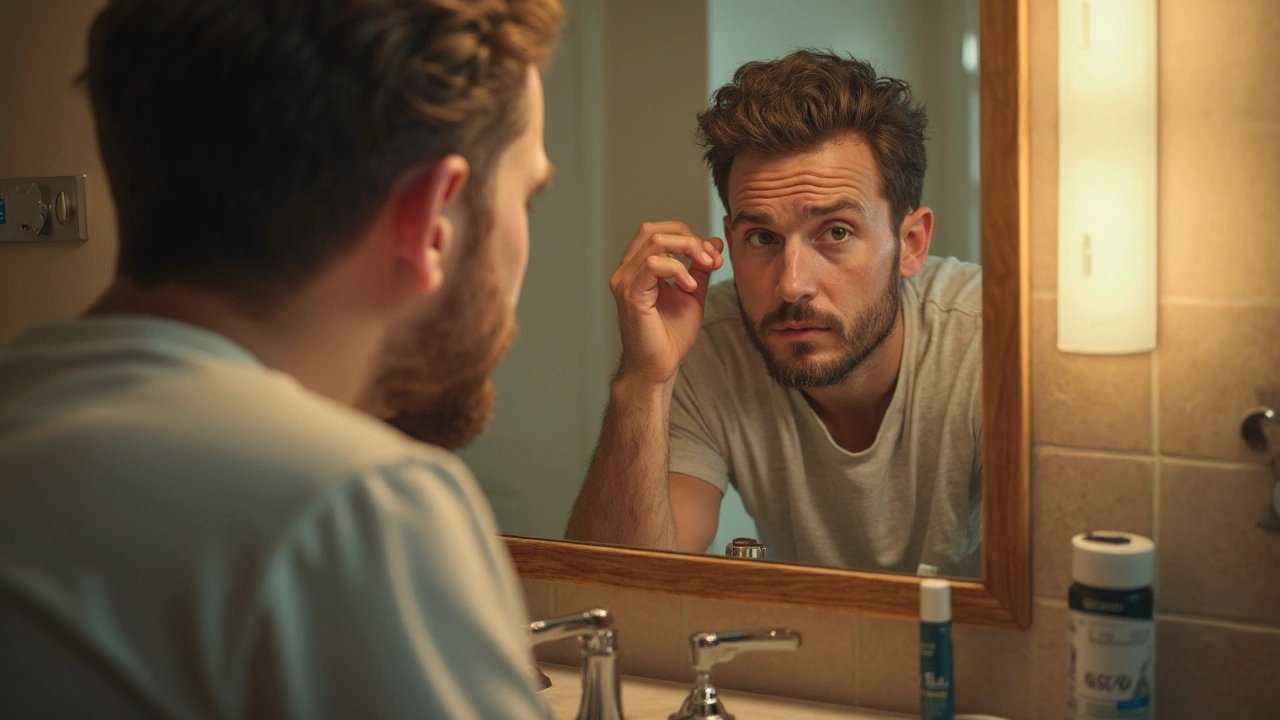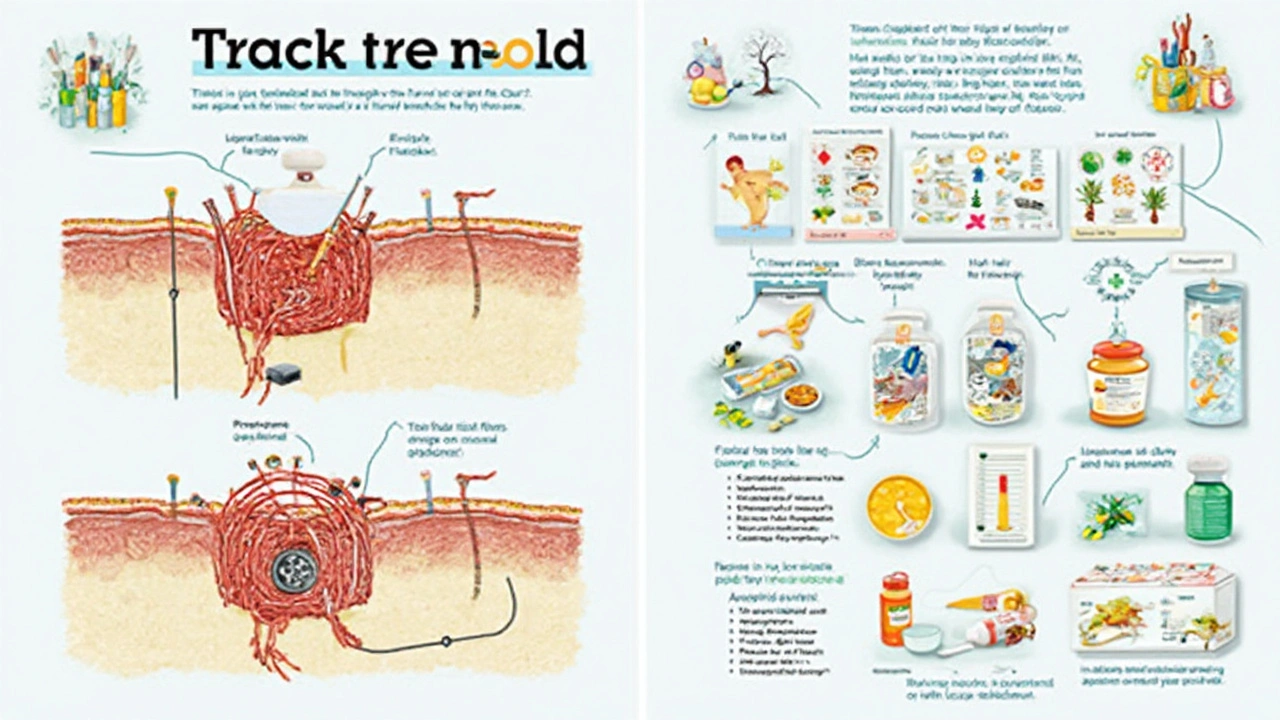Finast: Key Facts, Benefits, and Side Effects of Finasteride for Hair Loss and Prostate Health
 Jun, 21 2025
Jun, 21 2025
Think you’re spotting more hair in the shower drain these days? Maybe your barber is gently mentioning those bare patches on your crown. Or, perhaps you’re wading through internet rabbit holes about men’s health and keep seeing the word “Finast” pop up. Behind the brand is finasteride, a medication with a fascinating backstory and some very real science. Let’s dig into what makes Finast tick, why people use it, what it can—and can’t—deliver, and what you should know whether you’re on the fence or already scrolling for online pharmacies.
What is Finast and How Does It Work?
Finast isn’t a mysterious new potion or a beauty influencer’s secret serum. It’s finasteride, a medication that’s been on the market for more than two decades, making headlines as both a balding remedy and a men’s health game-changer. Manufactured mostly in India and sometimes called its generic name, Finast is chemically identical to branded medications like Propecia and Proscar, but often sold at a fraction of the price. This little tablet is a 5-alpha-reductase inhibitor. It works by stopping testosterone from getting converted into dihydrotestosterone (DHT)—the troublemaker behind many cases of male pattern baldness and an enlarged prostate.
The science is pretty straightforward. The body naturally produces DHT, a male hormone that’s much more powerful than testosterone when it comes to binding hair follicles (the roots of your hair). For some unfortunate blokes, DHT signals hair follicles on the scalp to shrink and eventually stop working. That’s when hair starts thinning or falling out altogether. Finast targets the enzyme responsible for this conversion (5-alpha-reductase, if you like specifics), and blocks it. The result? Less DHT—and, for most users, less hair loss.
But here’s a twist most people don’t expect: Finast’s blocking powers reach beyond just hair. DHT drives the growth of the prostate, especially as men age. If the gland grows too much, men may develop benign prostatic hyperplasia (BPH), which means more nighttime trips to the loo, weaker urine flow, and that strange feeling your bladder’s never really empty. By reducing DHT levels, Finast helps shrink many enlarged prostates, easing those awkward problems. It’s a classic bit of two-for-one medicine—treating hair loss at low doses (typically 1mg daily), and BPH at higher doses (5mg daily). The UK National Health Service and the US FDA both recognize its uses.
For the skeptics, numbers don’t lie. In clinical trials, about 65% of men with male pattern baldness stopped shedding hair after twelve months of daily finasteride, and up to 48% saw new hair growth on thinning patches. Studies on BPH show significant symptom relief for around 70% of patients within six months. Unlike minoxidil (the rub-on foam or lotion), Finast works from the inside out. In other words, you swallow it, rather than apply it to your scalp.
Important fact: If you want to give Finast a go, you’ll need daily use—skipping days or cycling won’t do much. It may take three to six months before you see real changes, and stopping will undo benefits over time. Think of it as a subscription rather than a quick fix.

Benefits, Results, and What to Expect When Taking Finast
The first thing anyone asks is: will it really save my hair? For most men who start earlier in the balding process, the answer’s encouraging. The big benefit is keeping what you’ve got—in most studies, Finast halts further hair loss in two out of three men. Fresh hair regrowth happens in about half, especially on the crown and mid-scalp. Temples are stubborn, but you might still gain some coverage there. Just know, it won’t resurrect a long-gone hairline, but if you notice thinning in your twenties or thirties, you’re in the prime group that can benefit.
Finast isn’t a quick-acting spell. You’ll likely need to stick with it for three months just to see early results, and six to twelve months to judge full effects. People sometimes get discouraged and quit in the first few months, convinced it’s not working. But hair grows slowly—think of it like watching paint dry or waiting for your cat (like Nimbus, my longhaired troublemaker) to come out from under the bed when it’s raining outside. Patience pays off. If it works, you can keep most of your gains for years, as long as you don’t stop the tablets.
Treating enlarged prostate is where Finast truly shines for men over 50. DHT reduction helps the prostate shrink, which usually means peeing with less hassle and fewer urgent dashes to the bathroom at 3am. In one large study, men taking 5mg daily saw a 25% reduction in prostate volume after a year, and lower risk of needing surgery.
If numbers help you decide, here’s a look at official trial data:
| Condition | Finasteride Dose | Success Rate | Time to See Results |
|---|---|---|---|
| Male Pattern Baldness | 1mg daily | ~65% maintained, ~48% regrew hair | 3-12 months |
| Benign Prostatic Hyperplasia | 5mg daily | ~70% symptom relief | 3-6 months |
Tip: If you’re looking to maximize results, take Finast at the same time every day. Don’t double dose if you forget—spreading doses out over time is better for side effect avoidance anyway. Hair loss is genetic, so you may still lose some hair with age, but you’ll likely lose less and lose it slower.
There are hidden perks. Some men say their hair feels thicker or healthier after a year or two. Others like that they’re not constantly splurging on shampoos, serums, or expensive laser combs. A few report that their confidence takes a leap—true, hair shouldn’t define self-worth, but we all know it sometimes sneaks into the equation.
Just don’t expect miracles. If you’ve been bald for a decade, you won’t suddenly get teenage locks. Another realistic tip: keep up with checkups. Your GP should monitor any medications, especially if you’re taking other pills, have low mood, or worry about prostate cancer. Finasteride can lower PSA (prostate-specific antigen) scores, so remind your doctor if you’re being screened for cancer (otherwise, scores could look lower than they are).

Risks, Side Effects, and Tips for Safe Use
No drug is totally free from side effects—and Finast is no different. Most guys tolerate it just fine, but you should know what can happen so you’re not caught off guard. The number one talked-about side effect? Sexual stuff. Some men report lower sex drive, trouble keeping erections, or less semen volume. The scary headlines make it sound common, but in real world studies, somewhere between 1–2% of users get these problems, and most find them reversible if the tablet is stopped. Less than 1 in 100 men may experience persistent effects even after quitting, which doctors call Post-Finasteride Syndrome (PFS), but there’s still debate about how often it really happens.
Other possible side effects pop up too, like breast tenderness, mild swelling in hands or feet, or feeling generally tired. In rare cases, men can get allergic skin reactions, or develop lumps under the nipple area (gynecomastia). If you notice any of these, check with your doctor—they’ll be able to set your mind at ease or help you decide whether to stop. For guys with a strong family history of breast or prostate cancers, a careful chat with your GP before starting Finast is wise.
A few safety tips really help:
- Never share Finast with women or children. Pregnant women shouldn’t touch broken tablets—finasteride can harm male babies.
- Be honest with your doctor about all medications and supplements you use, as interactions are rare but possible.
- If you notice lumps, pain, or nipple discharge—definitely get checked out.
- If you’re being monitored for prostate cancer, remind your healthcare provider you’re taking Finast, as it lowers PSA results by about 50%.
- Store your tablets away from pets—I once caught Nimbus, my cat, batting a stray pill across the kitchen. Cats getting into meds is a real headache.
Most side effects show up in the first few weeks to months. For those who stick with it, the odds of problems drop quickly. And plenty of men never notice a thing except fuller hair or easier bladder time.
Wondering about drinking, food, or supplements? Finast can be taken with or without food. There’s no hard evidence that booze messes with it, but like most meds, moderation is wise. Some online forums hype up pairing finasteride with minoxidil for extra regrowth (the combo is safe and sometimes more effective), though minoxidil does more for receding hairlines and frontal baldness than finasteride alone. Prescription is needed in the UK, but online clinics make remote ordering straightforward—with pharmacist checks and discreet delivery.
Alternatives exist. If you’re not keen on pills, there are topical finasteride sprays and foams on prescription now, promising less risk of sexual side effects, though long-term data is still early. And if pills sound like hard work, hair transplant surgery isn’t for everyone, but remains popular for those with deep pockets and expectations managed. Wigs and hair fibers have come a long way too—sometimes, the easiest solution is a buzzcut and a strong hat collection.
Finast has earned a spot as a go-to for men’s hair and prostate health. If you’re struggling with these issues, chat with your doc, weigh up the benefits and risks, and make whatever choice keeps you happy—hair or no hair, it’s your call.
Jonathan Mbulakey
July 18, 2025 AT 17:39Reading through this detailed breakdown of Finast, I'm reminded how complex these treatments really are despite their widespread use.
Finasteride acts by inhibiting the conversion of testosterone to dihydrotestosterone (DHT), which is pretty fascinating given how that simple hormonal tweak can target hair loss and prostate enlargement. But even with its effectiveness, I believe there's always a tradeoff in safety and side effects. For instance, the risk of sexual dysfunction is worth close consideration if someone is thinking about taking this drug long-term.
Moreover, this article wisely brings up alternatives and safety tips, which are essential since not everyone can tolerate finasteride or may want to explore natural ways first. I appreciate that this is not just a promotion but a genuinely informative piece.
What do others think about the balance between benefits and side effects, especially for younger guys worried about hair thinning?
Deborah Escobedo
July 22, 2025 AT 16:22This is quite a helpful overview, especially clarifying that while finasteride is effective, it’s not a miracle cure and users should set realistic expectations. I think it's important to stress how patience is key because results often take months to notice.
The article’s highlights on safety and side effects were clear and balanced, which helps reduce unnecessary fear. It’s also good to remember that finasteride isn’t suitable for everyone, so consulting a doctor prior to starting is crucial.
For those dealing with prostate issues, understanding these drugs can really improve quality of life. But it was refreshing to also read about natural alternatives and lifestyle adjustments since medication isn’t the only path.
What I liked most was the gentle encouragement to be well-informed rather than rushing into treatments blindly.
Dipankar Kumar Mitra
July 27, 2025 AT 16:05Honestly, this post is a decent intro but I'm skeptical about just how often finasteride is touted without enough attention to its nasty side effects especially when it comes to emotional and libido issues.
Sure, it works on hair and prostate but at what cost? I've talked to people who've been wrecked emotionally, had brain fog, and way reduced desire. The article mentions side effects but kinda skirts around the darker realities.
I get needing alternatives and safety tips but too many blindly trust this stuff because it’s prescribed. We need more big-picture talk about mental health impacts.
And the whole buy-from-where section — folks really need to ensure they’re getting legit meds and not some sketchy product that could be worse.
Just sharing what I've seen and experienced. Anyone else feel this way?
Tracy Daniels
August 1, 2025 AT 15:49Hey everyone! 😊 What a comprehensive post this is! I really appreciate how it thoughtfully dives into the various effects of finasteride, including both benefits and the potential side effects.
Many people don’t realize that while the medication can greatly help with hair loss and prostate health, it's important to monitor oneself closely and maintain ongoing conversations with healthcare providers.
Also, the suggestions about alternatives and safety tips offer a balanced view, empowering readers to make informed decisions rather than feeling overwhelmed or pressured.
A lot of stigma still surrounds these treatments, so talking openly about experiences and concerns can help us all feel more supported. Thanks for sharing this!
Jean-Sébastien Dufresne
August 5, 2025 AT 14:32Ah yes, finasteride—Canada must keep an eye on imports and pricing cuz this stuff can be pricey as heck! One thing that’s often overlooked is how attitude towards medication varies here compared to the US.
People down south push meds hard, but up here, many folks are suspicious or cautious. This article does well outlining pros and cons but I reckon local availability and cost will make or break user decisions too.
And let’s face it, finding a good doc to explain it all properly can be a nightmare. If anyone's tried alternatives, spill the beans! I’m curious if natural supplements really stack up or is this just a myth?
Also gotta use the right emojis: 💊🍁 #CanadaView
Patrick Nguyen
August 9, 2025 AT 13:15From a clinical perspective, the pharmacodynamics of finasteride are well understood but patient variability in response warrants attention.
The mechanism, involving 5-alpha reductase inhibition, effectively decreases DHT production, which underpins its role in male pattern baldness and benign prostatic hyperplasia.
However, strict adherence to prescribed dosing and continual monitoring for adverse effects is paramount. We must balance efficacy with patient safety, being vigilant about rare but serious side effects.
Additionally, patient education about realistic expectations and timeframe of observable benefits can improve compliance and satisfaction.
A thorough consultation remains indispensable before initiating therapy.
Fiona Doherty
August 13, 2025 AT 11:59Look, finasteride sounds nice on paper but I’m tired of seeing it hyped as some magic pill. It’s not without faults and frankly, a lot of people end up disappointed or worse battling side effects no one warned about properly. No thanks.
This write-up seems too sanitized. Where’s the grit? The real stories? People should stop blindly trusting big pharma marketing and dig deeper. There’s no one-size-fits-all in medicine.
If you’re considering this, do yourself a favor and research past the glossy summaries. Talk to people, look for multiple opinions and lower your expectations of perfection from this medicine.
Neil Greer
August 17, 2025 AT 10:42I got a buddy who’s been using finasteride for years with zero hassle. Hair stayed solid, no issues at all. Seems like side effects are really a mixed bag and maybe depend on the person’s build or genetics.
I think it’s important not to freak out about worst case stuff without seeing how the drug affects you personally. That said, always good to keep an eye on any changes.
Also, the alternatives seem like supplements just trying to cash in on bad hair days, but some might help with scalp health at least.
Not a doctor, just sharing what I’ve seen and mentioned to my mates who’re interested.
Fionnuala O'Connor
August 17, 2025 AT 19:19This post serves as a solid starter. I appreciate the minimalist punctuation and clear language used; it makes accessing complex information easier.
For individuals hesitant about meds, the emphasis on safety and consideration of alternatives creates space for more conscious decision-making. Often, hair loss treatments are rushed into without full awareness.
The detailed side effects section encourages readers to recognize early warning signs and seek medical help without delay.
Ultimately, the article feels supportive, aiming to empower rather than alarm.
Christopher MORRISSEY
August 17, 2025 AT 22:05In the intricate tapestry of biomedicine, finasteride emerges as a particularly interesting agent, bridging dermatology and urology. The nuanced interplay between hormonal regulation and pathophysiology reflected in its usage warrants renewed academic discussion.
Notably, it manifests a dual mechanism with multifaceted benefits, yet it behooves clinicians to maintain vigilance regarding adverse phenomena, both somatic and psychological. One might consider the sociocultural backdrop influencing patient perceptions and acceptance of pharmacological interventions.
Interdisciplinary approaches and longitudinal studies will surely enrich our understanding of finasteride's full impact on patient quality of life.
Adam O'Rourke
August 17, 2025 AT 22:05Oh, here we go with yet another 'wonder drug' post. Finasteride, the supposedly miraculous potion for hair that’s really just a chemical gamble! 🙄
Yes, it blocks DHT and yes, some folks swear by it, but I bet there are plenty swirling in regret and silent misery from all the 'minor' side effects no one talks about at parties.
Honestly, if you want to risk your mojo for some strands of hair, suit yourself. Just don't be surprised when things don’t go as shiny as the ads.
Disclaimer: This comment absolutely comes with a hefty dose of sarcasm and seasoned skepticism.